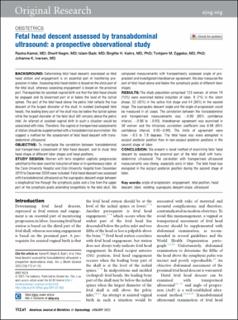| dc.contributor.author | Kamel, Rasha | |
| dc.contributor.author | Negm, Sherif | |
| dc.contributor.author | Badr, Islam | |
| dc.contributor.author | Kahrs, Birgitte Heiberg | |
| dc.contributor.author | Eggebø, Torbjørn M. | |
| dc.contributor.author | Iversen, Johanne Kolvik von Ely | |
| dc.date.accessioned | 2022-02-15T09:01:16Z | |
| dc.date.available | 2022-02-15T09:01:16Z | |
| dc.date.created | 2021-09-20T15:52:53Z | |
| dc.date.issued | 2021 | |
| dc.identifier.citation | American Journal of Obstetrics and Gynecology. 2021, 226 (1), 1-10. | en_US |
| dc.identifier.issn | 0002-9378 | |
| dc.identifier.uri | https://hdl.handle.net/11250/2978981 | |
| dc.description.abstract | Background Detection of copy number variation (CNV) in genes associated with disease is important in genetic diagnostics, and next generation sequencing (NGS) technology provides data that can be used for CNV detection. However, CNV detection based on NGS data is in general not often used in diagnostic labs as the data analysis is challenging, especially with data from targeted gene panels. Wet lab methods like MLPA (MRC Holland) are widely used, but are expensive, time consuming and have gene-specific limitations. Our aim has been to develop a bioinformatic tool for CNV detection from NGS data in medical genetic diagnostic samples. Results Our computational pipeline for detection of CNVs in NGS data from targeted gene panels utilizes coverage depth of the captured regions and calculates a copy number ratio score for each region. This is computed by comparing the mean coverage of the sample with the mean coverage of the same region in other samples, defined as a pool. The pipeline selects pools for comparison dynamically from previously sequenced samples, using the pool with an average coverage depth that is nearest to the one of the samples. A sliding window-based approach is used to analyze each region, where length of sliding window and sliding distance can be chosen dynamically to increase or decrease the resolution. This helps in detecting CNVs in small or partial exons. With this pipeline we have correctly identified the CNVs in 36 positive control samples, with sensitivity of 100% and specificity of 91%. We have detected whole gene level deletion/duplication, single/multi exonic level deletion/duplication, partial exonic deletion and mosaic deletion. Since its implementation in mid-2018 it has proven its diagnostic value with more than 45 CNV findings in routine tests. Conclusions With this pipeline as part of our diagnostic practices it is now possible to detect partial, single or multi-exonic, and intragenic CNVs in all genes in our target panel. This has helped our diagnostic lab to expand the portfolio of genes where we offer CNV detection, which previously was limited by the availability of MLPA kits. | en_US |
| dc.language.iso | eng | en_US |
| dc.publisher | Elsevier Ltd. | en_US |
| dc.rights | Navngivelse 4.0 Internasjonal | * |
| dc.rights.uri | http://creativecommons.org/licenses/by/4.0/deed.no | * |
| dc.title | Fetal head descent assessed by transabdominal ultrasound: a prospective observational study | en_US |
| dc.type | Peer reviewed | en_US |
| dc.type | Journal article | en_US |
| dc.description.version | publishedVersion | en_US |
| dc.source.pagenumber | 1-10 | en_US |
| dc.source.volume | 226 | en_US |
| dc.source.journal | American Journal of Obstetrics and Gynecology | en_US |
| dc.source.issue | 1 | en_US |
| dc.identifier.doi | 10.1016/j.ajog.2021.07.030 | |
| dc.identifier.cristin | 1936214 | |
| cristin.ispublished | true | |
| cristin.fulltext | original | |
| cristin.qualitycode | 2 | |

